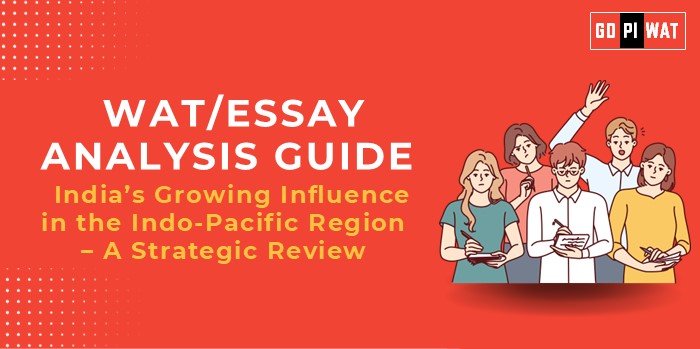📋 WAT/Essay Analysis Guide
📝 Topic: India’s Growing Influence in the Indo-Pacific Region – A Strategic Review
🌐 Understanding the Topic’s Importance
🌏 Significance: India’s Indo-Pacific strategy intertwines with its goals for economic growth, maritime security, and geopolitical relevance. For B-schools, it highlights lessons in international business, policy analysis, and leadership.
📝 Effective Planning and Writing
- ⏳ Time Allocation:
- 🕒 Planning: 5 minutes.
- 🖊️ Writing: 20 minutes.
- 🔍 Review: 5 minutes.
- 📋 Preparation Tips: Note updated statistics like defence export growth and ASEAN trade data.
💡 Introduction Techniques for Essays
- ⚖️ Contrast: “While India emerges as a leader in the Indo-Pacific, regional challenges like China’s maritime dominance test its resolve.”
- 🔑 Solution-Based: “Through strategic diplomacy and naval modernization, India is poised to shape the Indo-Pacific narrative.”
- 📜 Timeline: “From Act East Policy in 1992 to Quad partnerships, India’s Indo-Pacific engagement reflects a strategic evolution.”
🛠️ Structuring the Essay Body
- 🏆 Achievements:
- ⚓ Maritime Trade Security: Over 90% of India’s trade by volume passes through the Indo-Pacific.
- 📈 Bilateral Trade with ASEAN: Reached USD 110.39 billion (2021-22).
- 🔧 Defence Exports: Grew by 32.5% in 2023 to ₹21,083 crore.
- ⚠️ Challenges with Comparative Analysis:
- 🌏 China’s Belt and Road Initiative: Outpaces India in infrastructure development.
- ⚖️ Regional Instability: Conflicts in the South China Sea complicate strategies.
- 🌟 Future Outlook:
- 🌊 Blue Economy: Expansion of sustainable maritime initiatives.
- 💻 Digital Infrastructure: Strengthening cybersecurity and trade logistics.
📄 Concluding Effectively
- ⚖️ Balanced Conclusion: “India’s Indo-Pacific strategy balances economic goals with regional challenges, emphasizing diplomacy and security.”
- 🌍 Global Comparison: “By aligning with Quad nations, India can mirror the success of Japan’s strategic regional investments.”
📊 Analyzing Successes and Shortcomings
🎯 Key Achievements
- 💼 Economic Engagement: ASEAN-India Free Trade Area boosted trade to USD 110.39 billion.
- ⚔️ Defence and Security: INS Vikrant enhances maritime capabilities, while defence exports demonstrate growing partnerships.
- 🤝 Strategic Diplomacy: Comprehensive Strategic Partnership with ASEAN and active Quad participation.
- 📦 Maritime Connectivity: Over 90% of trade volume underpins India’s economic role in the Indo-Pacific.
⚠️ Ongoing Challenges
- 🇨🇳 China’s Expanding Influence: Belt and Road Initiative and militarization in the South China Sea challenge India’s position.
- 🏗️ Infrastructure Deficits: Delays in critical projects like the Chabahar Port.
- ⚔️ Geopolitical Instability: Shifting dynamics among Quad partners create uncertainties.
- 💰 Resource Constraints: Limited spending on defence and infrastructure compared to other powers.
🌍 Global Context
- 🇯🇵 Japan: Success through robust infrastructure financing under its Partnership for Quality Infrastructure.
- 🇨🇳 China: Dominates through the Belt and Road Initiative, pressuring India to innovate with ASEAN and Quad partnerships.
- 🇺🇸 USA: Emphasizes collaboration with India to counterbalance China, presenting opportunities and responsibilities.
🔑 Recommendations for Sustainable Progress
- 🤝 Enhance Public-Private Partnerships: Drive regional connectivity and infrastructure projects.
- ⚔️ Invest in Defence Indigenization: Strengthen India’s defence manufacturing capabilities.
- 💻 Strengthen Digital Infrastructure: Modernize maritime logistics and improve cybersecurity.
📚 Sample Short Essays (100 Words Each)
- 📋 Balanced Perspective: “India’s Indo-Pacific engagement is a mix of economic ambition and security imperatives, requiring nuanced strategies for success.”
- 🔍 Solution-Oriented: “To address regional challenges, India must prioritize infrastructure development and strengthen alliances.”
- 🌍 Global Comparison: “By leveraging Quad partnerships, India can emulate Japan’s balanced approach to regional leadership.”


